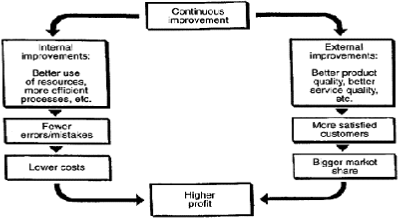Continuous Improvements In Quality
Introduction:
Continuous improvement is directly linked with the high quality. The main aim of internal quality improvements is to make the internal processes ‘leaner’, i.e. to prevent defects and problems in the internal processes which will lead to lower costs.
Methods of achieving quality:
Higher quality both should and can be achieved through:
1. Internal quality improvements:The main aim of internal quality improvements is to make the internal processes ‘leaner’, i.e. to prevent defects and problems in the internal processes which will lead to lower costs.
2. External quality improvements: external quality improvements are aimed at the external customer, the aim being to increase customer satisfaction and thereby achieve a bigger market share and with it, higher earnings.
- Both types of improvements are closely connected with the questions top management asks at the annual quality audit.
- These questions, together with the answers, are not only important in connection with the quality audit.
- The whole exercise should gradually develop to become an integral part of the company’s quality culture, with the questions being regularly asked by all employees in all departments and all employees actively participating in answering them by suggesting quality improvements.
- Education and training are only two, albeit necessary, conditions for the involvement of the firm’s employees. They are far from sufficient.
- However, continuous improvements also require ‘leadership’, which was also part of the TQM pyramid.
- Without this solid foundation, the four sides of the ‘pyramid’ will never be built

Fig: Continuous improvements and their consequences.